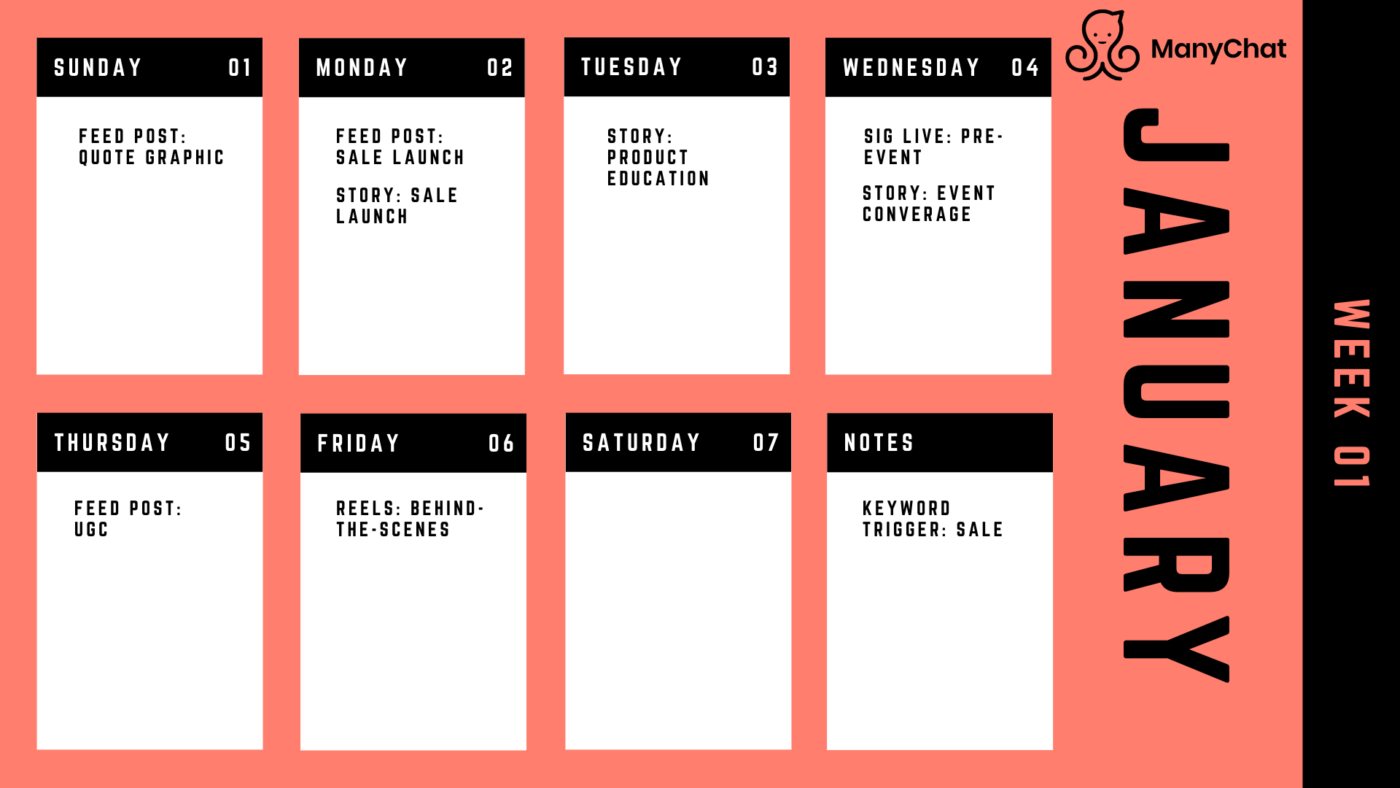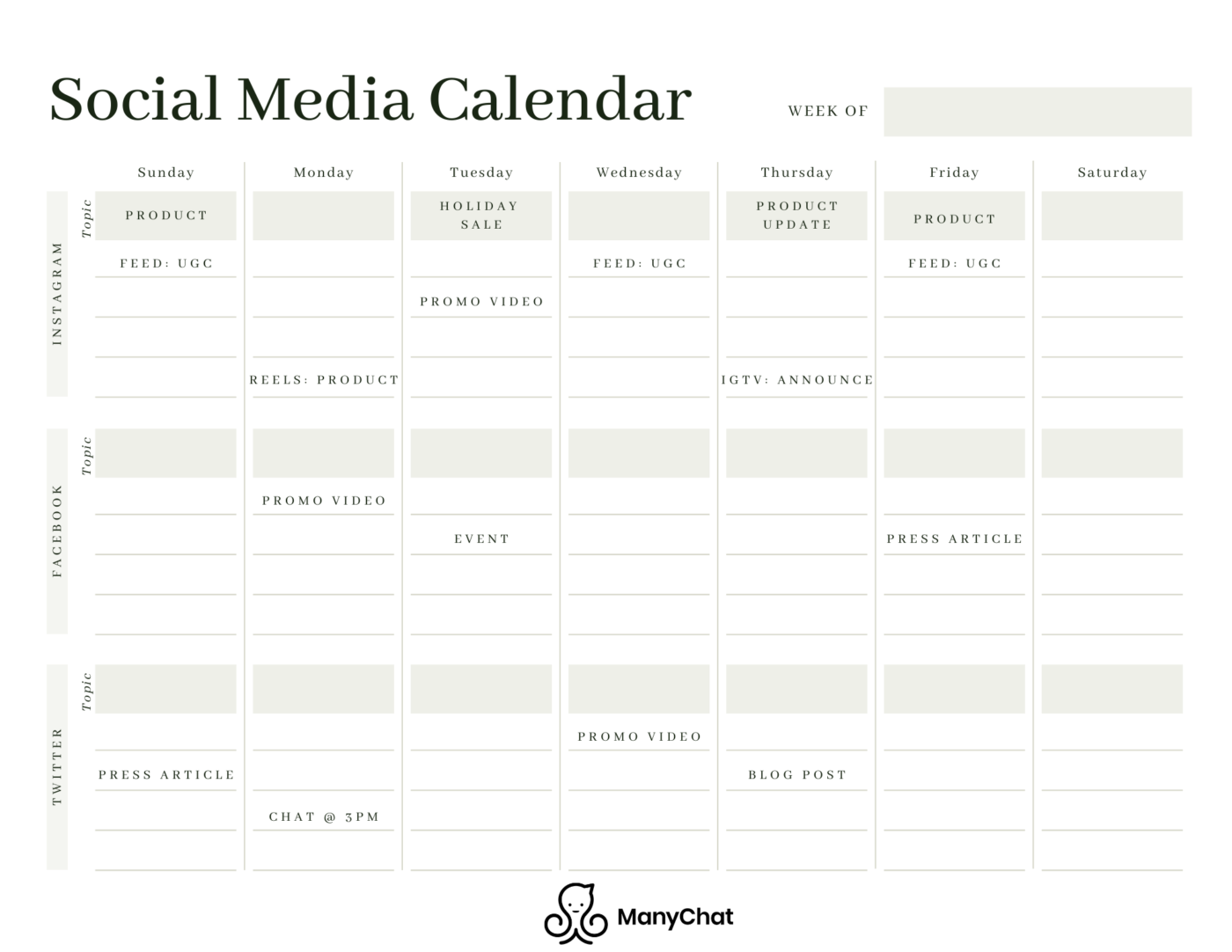Real Examples of Instagram Content Calendars


Written by Holly Phillips
October 11, 2021
Social media can be an overwhelming marketing channel, especially when you’re trying to be strategic and achieve optimal results from your efforts. Here’s some good news: A large part of being successful on social media is a result of planning, not plain luck.
Without a plan, you risk not having something to post and scrambling to get something together, which may not perform well because it wasn’t your best work.
You can avoid all of the mess and stress by creating a social media content calendar! We’re going to focus specifically on creating an Instagram content calendar, but you can use one for any platform where you publish content. We’ll explain exactly how to approach it and show some examples so you can make yours today.
Why create an Instagram content calendar
The sheer number of Instagram posts—including Stories, Reels, and feed posts—you need to ensure your profile stays top-of-mind with followers can be overwhelming if you don’t plan ahead of time.
Creating a content calendar for all of your Instagram posts helps you determine what content you need, especially if you’re running specific marketing campaigns. Planning also gives you and your team more time to create quality assets and get them approved.
For example, suppose your Instagram videos need editing, and someone else writes the captions. In that case, you can detail all of that information in your content calendar, and every department in your company will be well-informed at all times.
A content calendar also catalogs all of your ideas in one place, which helps keep campaigns and content ideas organized. Not only will you be able to see the topics you’re covering, but you can also identify any content gaps.
Consistency is critical for Instagram—and creating a content calendar will help with this. Not only do you want to publish high-quality content on Instagram, but you want to do it day after day. Adding the publish date into your calendar will show you any days you’re missing or where you should move content.
How do I create an Instagram content calendar?
Your Instagram content calendar can be as straightforward or as complex as you wish. Use it to plan whatever works best for your business: two weeks, a month ahead, six months, etc. But, let’s take it step-by-step:
First, go back to your social media strategy. If you don’t have one, work on that before drilling down to Instagram. Ultimately, you want everything you do on Instagram to align with your overall social media strategy. Here are some questions you can ask when determining your strategy:
- What are we trying to accomplish with our brand’s account?
- Who is responsible for publishing posts for this account?
- How will the brand be reflected in our posts?
- What types of content will we publish?
- How often will we publish content?
Next, take a look at what you’ve published on Instagram in the past. Make a note of posts that have done well. Are there similarities among posts that get more engagement? If so, that’s something you’ll want to keep in mind as you build your Instagram calendar. There’s no point in continuing to publish content that doesn’t perform well with your target audience.
Next, it’s time to select an Instagram content calendar template. Keep in mind there are several different ways you can approach your calendar; it’s essential to do whatever works best for your social media manager and team.
You can use a spreadsheet to create your calendar via Google Sheets or Excel, or even an actual calendar layout to display what will be published, on which platform, and on what date. Of course, you can use always planning tools to help you, such as:
- Evernote: Offers a simple, clean layout for weekly social media planning
- Hootsuite: An industry-standard program that enables you to plan and schedule social media posts for publishing
- Hubspot: Download a traditional calendar template that has space for several social platforms via a spreadsheet
- Trello: A tool offering more of a conventional calendar interface with movable assignment cards for specific tasks
If your team already uses a time management tool, such as Asana or Monday, you could potentially use them as well.
Instagram content calendar examples
Now, let’s take a look at some Instagram content calendar examples:
This content calendar template uses a color-coded approach to represent the content type. All of the blue squares are Instagram Live content, purple represents static feed posts, pink is for Instagram Reels, etc. Using color means you don’t have to keep labeling every post, so this option is good for those who are using several features of the app.
This is a calendar template that focuses on one week at a time. You can set it up to show what will be published or what’s due, whichever information works best for you. You could also use the notes section for content ideas or anything that doesn’t belong on a specific day, such as a campaign reminder or a weekly theme.
This Instagram content calendar could be weekly or monthly, as its focus is more on the type of Instagram content you’re planning to publish. It would work best if you plan on publishing different content types at various times throughout the day, such as an Instagram post for the feed at noon and an Instagram Reel at 6pm.
Another content calendar template option integrates your Instagram calendar into your overall editorial calendar. This monthly view can house all of your upcoming content, including blog posts, marketing emails, and posts for other social media platforms. Although this method makes for a more complex calendar, it does help you visualize how all of your content works together (or where it needs help).
Here’s another example of a more complex social media content calendar that includes ideas for Facebook, Instagram, and Twitter (you could add additional social media platforms if you adopt this version). This calendar template is weekly but could easily be transformed into a monthly view. Pro tip: If you use Excel to create this, you could link specific content ideas to additional spreadsheets where you can add more detail, such as ideas for graphics, keywords, or hashtags.
On any of these calendar templates, you might consider adding your Instagram DM Automation campaigns as well. For example, if you’re running a specific contest via automation or using a particular keyword trigger, your content calendar could contain that information so all Instagram-related efforts are in one place.
No matter which template you choose—or if you make one from scratch—having an Instagram content calendar will help you be more strategic on the platform, leading to better results.
Ready to try Instagram DM Automation by ManyChat?





